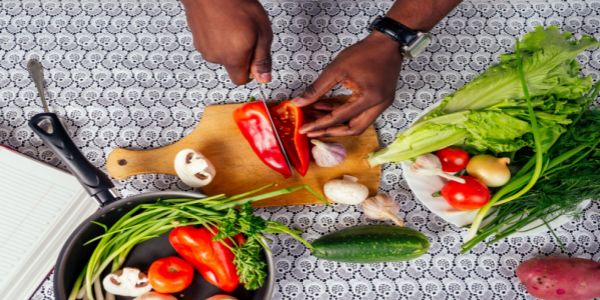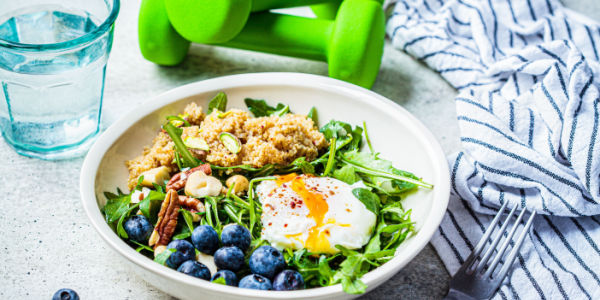
When making long-term changes for your overall health, like weight loss, it’s easy to feel like dramatic changes are needed. Surprisingly, small tweaks can make a big difference.
Instead of limiting intake excessively, make tiny diet tweaks to lose weight and create sustainable healthy habits. Read on for five tiny eating tweaks you can make today for mighty results!
What Are Diet Tweaks to Lose Weight?
When it comes to diet, you don’t necessarily need to make big changes to get significant results. Small changes may be more manageable.
Over time, these small changes become significant and sustainable healthy habits that impact your life in the long term. In fact, research on weight loss supports small, slower changes over rapid weight loss.
Making small tweaks and more manageable changes means you don’t have to sacrifice your favorite flavors. Weight loss is often treated like a chore instead of an enjoyable health experience.
By employing small tweaks instead of rapid, dangerous weight loss tactics, you’re supporting both your body and mind while making meaningful changes.
5 Tiny Eating Tweaks
Instead of overhauling your entire routine, there are subtle yet significant ways to tweak your habits and make them healthier. Here are five effective weight loss tips you can try today.
Drink Water
One of the best steps you can take when trying to lose weight is to replace sugary drinks with a glass of water. Water is considered the “gold standard” of hydration and keeps you nourished while adding 0 calories—and you can drink more water with ease in many ways!
Setting reminders on your computer or phone (or some other place that is regularly visible to you) can help remind you to drink. Beverage containers with markers for a certain amount of time—like every two hours, with the first marker at 7:30 AM, the second at 9:30 AM, and so on—can remind you to keep hydrated throughout the day. Some even have motivating sayings such as “drink up!” to make staying hydrated more fun.
A habit many find helpful is to drink at least 1, 8-ounce glass of water before the first meal of the day. Some repeat this habit before every meal and snack, making getting at least 8, 8-ounce glasses of water each day easier.
Getting bored with plain water? Remember sparkling water, fruit-infused water, or 100% juice (with no added sugars) are also excellent options.
You can also count water-rich foods—like watermelon—or beverages—like milk or almond milk—as sources of hydration, too.
Switch to Lean Meats & Proteins
Lean protein allows you to feel fueled while enjoying your usual portion size. You can eat lean meats without guilt, knowing they contain fewer saturated (unhealthy) fats and calories compared to their red meat counterparts.
The best lean meats and fish for weight loss include:
• Canned tuna
• Chicken breast
• Ground turkey
• Pork tenderloin
• Salmon
• Sirloin
Other lean protein sources to add include:
• Eggs, especially egg whites
• Non or lower-fat dairy sources like cottage cheese, Greek yogurt, and milk
• Legumes such as beans and lentils
• Soy foods, including edamame, tempeh, and tofu
Make Your Grains Half & Half
If you’re used to eating refined grains, switching to whole grains “cold turkey” can seem like a big step. Instead, swap half the grains on your plate for whole grains. For example, you could mix white and brown rice together
Surprisingly, many grains pair well with one another and taste great mixed with most veggies. Try mixing brown rice with quinoa or even cauliflower rice. Doing this can help mix up ingredients that feel mundane and make mealtime more exciting.
Add An Extra Serving Of Veggies
Like fruits, vegetables provide plenty of nutrients your body needs each day. Plus, many vegetables are considered low-calorie. In other words, you can add an extra serving of veggies to your plate to help you feel full without adding too many calories.
To make vegetables more appealing, you can set a goal to try a new one—or a new veggie cooking method—each week. This practice can open you up to new flavor possibilities. And you may find a new favorite or ways to make side dishes the star of the show!
You can “hide” veggies in meals, too! This may be preferable if you aren’t a fan of veggie flavors. Sneak them into favorites like mac and cheese, burgers, and casseroles.
Don’t forget frozen and canned vegetables can also be nutritious and delicious. Just be sure to check the label before purchasing to ensure that added salt is kept to a minimum.
Focus on Filling Foods
It may sound counterintuitive, but eating enough food is important when you’re trying to lose weight. For this reason, it’s risky to skip meals as part of your weight loss efforts. Eating too little can put your body into “survival mode,” which means your body won’t necessarily be focused on losing weight.
On the contrary, incorporating more foods with filling nutrients into each meal and snack can make weight loss more effective. In particular, protein, fiber, and healthy fats can help you to feel full.
They also take longer to digest, meaning you’ll feel satisfied and satiated between meals. Additionally, these nutrients can help to balance blood sugars, which can help keep energy levels constant throughout the day.
Greek yogurt is a popular favorite among weight loss enthusiasts. This is largely due to its high protein content, as well as its versatility in almost any meal—from breakfast parfaits to an ingredient in sauces and dips.
Peanut butter is another favorite and filling food to have on hand, although you’ll want to be mindful of portion size since calories can add up quickly.
The Last Word on Diet Tweaks for Weight Loss
The research about diet really does show that “slow and steady wins the race.” Rapid weight loss can be dangerous and have serious effects on health, while tiny eating tweaks support sustainable and long-term healthy habits.
Make weight loss more manageable by slowly incorporating more water, vegetables, lean meats, and whole grains into your diet.
References:
Back to Basics for Healthy Weight Loss. Academy of Nutrition and Dietetics. Published October 2018.
Frechman R. What a Healthy Weight Loss Plan Really Looks Like. Academy of Nutrition and Dietetics. Published June 2018.
Maintaining a Healthy Weight. National Institute on Aging. Published April 2022.
Small changes for a healthy heart. National Heart, Lung, and Blood Institute. Published February 2021.







